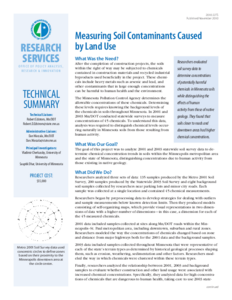Displaying results 1 - 10 of 26
The Impact of Roughness Elements on Reducing the Shear Stress Acting on Soil Particles
Creator
Date Created
2002
Report Number
2002-22
Description
Efficacy of Erosion Control Blankets and Soil Stabilizers
Date Created
2000
Report Number
2000-15
Description
The Effects of Fire Versus Mowing on Prairie Plant Communities
Date Created
2003
Report Number
2003-20
Description
Special Practices for Design and Construction of Subgrades in Poor, Wet, and/or Saturated Soil Conditions
Date Created
2003
Report Number
2003-36
Description
Quantifying Moisture Effects in DCP and LWD Tests Using Unsaturated Mechanics
Date Created
2014
Report Number
2014-13
Description
Statistical Analysis of the Soil Chemical Survey Data
Creator
Date Created
2010
Report Number
2010-22
Description
Performance-Based Measurement of Optimum Moisture for Soil Compaction
Creator
Date Created
2013
Report Number
2013-28
Description










